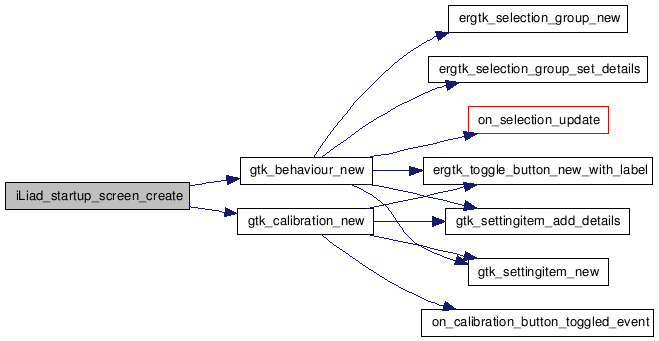settings/src/iLiadStartUpScreen.h File Reference
settings - users customized startup behaviour Screen More...
#include <sys/types.h>
#include "background.h"

Go to the source code of this file.
Classes | |
| struct | gtkBehaviour_t |
| struct | gtkCalibration_t |
| struct | gtkStartUp_t |
Defines | |
| #define | STARTUP_ITEM_PADDING_TOP 10 |
| #define | STARTUP_ITEM_PADDING_BOTTOM 10 |
| #define | STARTUP_ITEM_PADDING_LEFT 13 |
| #define | STARTUP_ITEM_PADDING_RIGHT 13 |
| #define | STARTUP_ITEM_SPACING 10 |
| #define | STARTUP_BEHAVIOUR_HEIGHT 300 |
| #define | STARTUP_CALIBRATION_HEIGHT 115 |
| #define | STARTUP_LABEL_WIDTH |
| #define | STARTUP_BUTTON_WIDTH 310 |
| #define | STARTUP_BUTTON_HEIGHT 27 |
| #define | STARTUP_BUTTON_NUMBER 9 |
Functions | |
| GtkWidget * | iLiad_startup_screen_create (void) |
| void | iLiad_startup_screen_set_text (void) |
| void | iLiad_startup_screen_display_data (void) |
| pid_t | get_xtscal_pid () |
| void | handle_xtscal_quit () |
| void | stop_xtscal () |
Detailed Description
settings - users customized startup behaviour ScreenCopyright (C) 2005-2008 iRex Technologies B.V. All rights reserved.
Providing GUI interface to let users input their customized startup behaviour.
Definition in file iLiadStartUpScreen.h.
Define Documentation
| #define STARTUP_BEHAVIOUR_HEIGHT 300 |
Definition at line 49 of file iLiadStartUpScreen.h.
| #define STARTUP_BUTTON_HEIGHT 27 |
Definition at line 57 of file iLiadStartUpScreen.h.
| #define STARTUP_BUTTON_NUMBER 9 |
Definition at line 59 of file iLiadStartUpScreen.h.
| #define STARTUP_BUTTON_WIDTH 310 |
Definition at line 56 of file iLiadStartUpScreen.h.
| #define STARTUP_CALIBRATION_HEIGHT 115 |
Definition at line 50 of file iLiadStartUpScreen.h.
| #define STARTUP_ITEM_PADDING_BOTTOM 10 |
Definition at line 43 of file iLiadStartUpScreen.h.
| #define STARTUP_ITEM_PADDING_LEFT 13 |
Definition at line 44 of file iLiadStartUpScreen.h.
| #define STARTUP_ITEM_PADDING_RIGHT 13 |
Definition at line 45 of file iLiadStartUpScreen.h.
| #define STARTUP_ITEM_PADDING_TOP 10 |
Definition at line 42 of file iLiadStartUpScreen.h.
| #define STARTUP_ITEM_SPACING 10 |
Definition at line 47 of file iLiadStartUpScreen.h.
| #define STARTUP_LABEL_WIDTH |
Value:
Definition at line 52 of file iLiadStartUpScreen.h.
Function Documentation
| pid_t get_xtscal_pid | ( | ) |
| void handle_xtscal_quit | ( | ) |
Definition at line 385 of file iLiadStartUpScreen.c.
00386 { 00387 // Remember child process gone 00388 g_xtscal_pid = 0; 00389 00390 // Refresh screen 00391 gtk_toggle_button_set_active(GTK_TOGGLE_BUTTON(g_startup.calibration.button), FALSE); 00392 // display_update_request_screen_refresh(MAIN_WINDOW_EXPOSE_LEVEL, WAVEFORM_FULLSCREEN); 00393 }
| GtkWidget* iLiad_startup_screen_create | ( | void | ) |
Definition at line 85 of file iLiadStartUpScreen.c.
00086 { 00087 GtkWidget *vbox; 00088 GtkWidget *behaviour; 00089 GtkWidget *calibration; 00090 00091 ST_LOGPRINTF("entry"); 00092 00093 memset(&g_startup, 0, sizeof(gtkStartUp_t)); 00094 00095 vbox = gtk_vbox_new(FALSE, STARTUP_ITEM_SPACING); 00096 g_startup.widget = vbox; 00097 00098 behaviour = gtk_behaviour_new(&(g_startup.behaviour)); 00099 gtk_box_pack_start(GTK_BOX(vbox), behaviour, FALSE, FALSE, 0); 00100 00101 calibration = gtk_calibration_new(&(g_startup.calibration)); 00102 gtk_box_pack_start(GTK_BOX(vbox), calibration, FALSE, FALSE, 0); 00103 00104 // show widgets 00105 gtk_widget_show(vbox); 00106 00107 return vbox; 00108 }

| void iLiad_startup_screen_display_data | ( | void | ) |
Definition at line 315 of file iLiadStartUpScreen.c.
00316 { 00317 startup_behaviour_t behaviour; 00318 GtkWidget* button; 00319 int i; 00320 00321 ST_LOGPRINTF("entry"); 00322 00323 behaviour = iLiad_startup_data_get_behaviour(); 00324 for (i = 0 ; i < STARTUP_BUTTON_NUMBER ; i++) 00325 { 00326 if (g_button_info[i].behaviour == behaviour) 00327 { 00328 button = g_startup.behaviour.buttons[i]; 00329 gtk_toggle_button_set_active(GTK_TOGGLE_BUTTON(button), TRUE); 00330 gtk_widget_grab_focus(button); 00331 } 00332 } 00333 }

| void iLiad_startup_screen_set_text | ( | void | ) |
Definition at line 291 of file iLiadStartUpScreen.c.
00292 { 00293 ST_LOGPRINTF("entry"); 00294 int i; 00295 00296 if (g_startup.widget) 00297 { 00298 gtkBehaviour_t* behaviour = &(g_startup.behaviour); 00299 gtkCalibration_t* calibration = &(g_startup.calibration); 00300 00301 gtk_settingitem_set_header_text(GTK_SETTINGITEM(behaviour->item), _("Start-up Settings")); 00302 gtk_label_set_text(GTK_LABEL(behaviour->label), _("Please select what to open when starting up your iLiad.")); 00303 00304 for (i = 0; i < STARTUP_BUTTON_NUMBER; i++) 00305 { 00306 gtk_button_set_label( GTK_BUTTON(behaviour->buttons[i]), _(g_button_info[i].text) ); 00307 } 00308 00309 gtk_settingitem_set_header_text(GTK_SETTINGITEM(calibration->item), _("Stylus calibration")); 00310 gtk_label_set_text(GTK_LABEL(calibration->label), _("With this function you can re-calibrate your stylus.")); 00311 gtk_button_set_label(GTK_BUTTON(calibration->button), _("Start Calibration")); 00312 } 00313 }

| void stop_xtscal | ( | ) |
Definition at line 395 of file iLiadStartUpScreen.c.
00396 { 00397 if (g_xtscal_pid != 0) 00398 { 00399 kill(g_xtscal_pid, SIGTERM); 00400 } 00401 }
 1.5.6
1.5.6